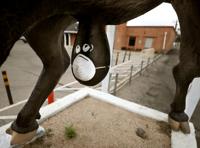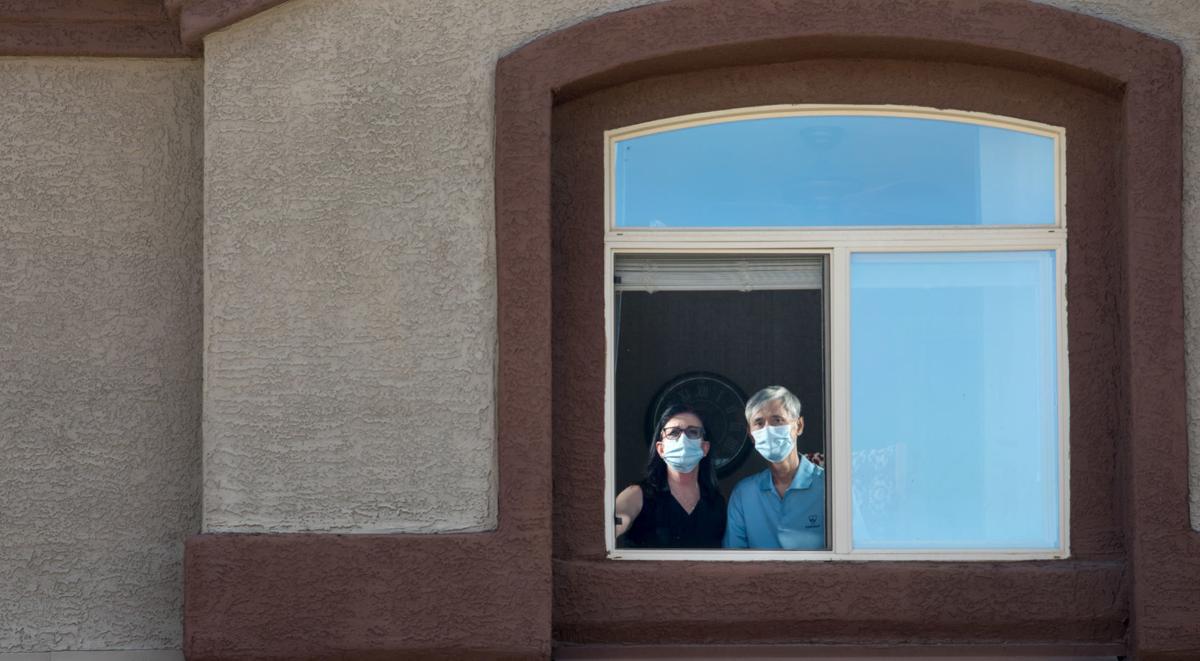After spending two months in the hospital with COVID-19, Michael Mariano wants more than anything for his life to return to normal. But like many patients who develop a severe respiratory illness, his road to recovery is far from over.
Mariano survived four weeks on a ventilator and two weeks on ECMO — a therapy that adds oxygen to a patient’s blood and pumps it through their body. The 62-year-old said he is left with a body and life that are vastly different from the ones he knew before he contracted the coronavirus.
While the long-term impacts of the novel coronavirus are largely unknown, the effects of extended ICU stays and intubation on severely ill patients are alarmingly clear. In the midst of a pandemic that has affected over 2.7 million people in the United States alone, some medical professionals are now concerned that the health-care system will continue to be overwhelmed by patients who are dealing with the aftermath of the coronavirus.
“It’s important that we highlight and anticipate these long-term problems and put in place policies, systems and infrastructure to take care of these patients long term,” said Dr. Christian Bime, director of the Medical Intensive Care Unit at Banner–University Medical Center Tucson. “Because COVID-19 has affected so many people at the same time, we will have a lot of survivors who will be needing these services. I anticipate that the health-care system will need to put in place the infrastructure to take care of the survivors.”
Many patients who become critically ill with COVID-19 develop a condition called acute respiratory distress syndrome, which causes fluid to build up in the lungs and deprive organs of oxygen. This is why many patients end up on a ventilator, a machine that helps the patient breathe so their lungs can heal.
“Because of the severity of the lung injury, the respiratory failure, these patients end up on the ventilator and also require a lot of drips to sustain their blood pressure, a lot of fluids, a lot of medications to make them comfortable and tolerate having the breathing tube down their throat,” Bime said.
While the use of a ventilator is necessary in a lot of these cases, being in the ICU and intubated for long periods of time can also lead to other conditions and complications. Often, critically ill patients are also at risk of complications that could bring them back to the hospital. Post-intensive care syndrome is a collection of physical, mental and emotional symptoms that continue even after leaving the hospital.
According to Bime, the most obvious impact is that patients become very deconditioned because they are essentially paralyzed while on the ventilator. It takes weeks, months and sometimes up to a year for critically ill patients to regain their strength, and it’s possible that they may never get back to where they were before.
In addition to the physical obstacles, Bime emphasized that long ICU stays can cause a variety of psychological and cognitive issues as well.
“By being in the hospital on all these drips that we use to sedate the patient, some patients develop what we call delirium. And that delirium can lead to, for some patients, the development of PTSD — post traumatic stress disorder — from just being on the ventilator and being in the ICU with all the noise and all the whistles and all the bells and whistles going,” he said. “Some patients also develop chronic anxiety and depression.”
Patients also have a number of medications that they have to manage following an ICU stay, which can be difficult, especially for older adults. The continued use of certain medications, without the guidance of a physician, could lead to additional complications as well.
“It was incredibly stressful”
After being admitted to Northwest Medical Center on April 8, Mariano was transferred to the ICU and placed on a ventilator less than 48 hours later.
Mariano’s wife, Robin Johnston, 64, also contracted the virus, but developed only mild symptoms. As health-care workers themselves, the couple had already seen the impact of the virus on the community and faced a lot of uncertainty while Mariano was in the hospital.
“The whole time, I had no idea if he was going to make it or not,” Robin said. “The staff was great about giving me updates about his progress, but you don’t know from one minute to the next if he’s going to make it and it was incredibly stressful.”
Even after going on the ventilator, Mariano didn’t seem to be getting better. In fact, he got worse.
“That traditional ventilation was failing for him, meaning that his hypoxia was resistant to the ventilator.” said Dr. Ryan Matika, co-medical director of the Intensive Care Unit at Northwest. “Essentially the ventilator itself can lead to worsening respiratory parameters, or worsening lung disease, that can have very long, if not permanent, effects.”
In order to protect Mariano’s lungs from the impact of the ventilator, his doctors decided it would be best to place him on ECMO, which basically acts as an artificial lung that circulates blood in and out of the body.
“We didn’t want a ventilator-associated injury to destroy his lungs. It leads you to long-term scarring if the lungs were damaged with the ventilator, which is why going in early is better,” said Dr. Zain Khalpey, chief of Cardiothoracic Surgery at Northwest.
By the time Mariano came off the ventilator and ECMO machines, the doctors continued to see the toll that the virus and the long-term intubation had on his lungs. Mariano then developed pneumonia and empyema, which is a collection of pus in the space between the lung and the inner surface of the chest wall.
Learning to walk again
Khapley, who performed surgery on Mariano to help drain the fluid, said “his lung looked like raw steak.”
“It was beaten up pretty badly, highly inflamed,” he said. “We could also see the long-term impact of the ventilator because there were bubbles all over his lung, which is called bullae. And that’s basically because of the cost of pressure that a ventilator gives to the lung and tends to bubble out the lung, causing irreversible damage.”
After an intensive hospital stay and multiple complications, Mariano continues to deal with the aftermath. He was released to a rehab center on June 8, where he stayed for three weeks and learned how to walk again.
Now back at home, Mariano said he has a long way to go before he can return to his active lifestyle of camping, golfing and riding his motorcycle. He goes to physical therapy two days a week and has a variety of other follow-up appointments to attend.
As a nurse for 40 years, Mariano isn’t sure when or if he’ll be able to return to work, but he remains hopeful that he’ll be able to take care of patients again in the future.
“Even with light activity, I get short of breath,” he said. “Right now, it’s so difficult to know what the future will look like. But I am making progress. I’ve learned a lot from this situation. It has given me perspective.”
Mariano is on seven different medications to support his heart and lungs. He also takes medicine to help him sleep, which he said is a direct result of the emotional symptoms he’s developed since being discharged.
“Since leaving the hospital, I’m not really sleeping like I was before,” he said. “I think the main reason is just being so afraid that something might happen while I’m sleeping”
Mariano also said he has vivid, dreamlike flashbacks of when he was in the ICU. He can’t remember much while he was sedated, but sometimes it comes back to him in pieces.
Even with a long road ahead, Mariano and his wife said they are just grateful that he’s still alive.
“When someone is near death, they sometimes say ‘I met an angel,’” Mariano said. “But the angels didn’t visit me. I’m still here.”
Supporting patients for the long term
With the many chronic conditions and complications that can arise after a severely ill patient is hospitalized, some local physicians say that finding a way to support COVID-19 patients in the long term is critical.
Bime and other Banner physicians are working with the Arizona Center on Aging to set up the infrastructure necessary to help see these patients through.
Similarly, Khapley at Northwest is working with his colleagues to build a lung recovery program that would essentially use smart technology to create better algorithms that would reduce ventilation times and help prevent additional lung injuries from occurring.
For Khapley, hospitals need to lead the charge when it comes to tracing patients and collecting data that will inform future research.
“We need to have a national database where we don’t just look at binary numbers of the positives, negatives, deaths and hospital beds. We’re trying to figure out how we can actually trace our patients,” he said.
“If we don’t do that in a smart way, then we certainly are just living from hand to mouth every single day and this thing’s never going to end. And so we have to be thinking more futuristically, and aggressively, about what we can do to try to make that happen.”
Photos: In Tucson, face masks are for more than just people
Face masks on objects
Updated
A Jeep sports with eyes like those from the movie "Cars" sports a COVID19 mask outside Alpha Graphics near the corner of Tanque Verde and Kolb, Tucson, Ariz., July 3, 2020.
Face masks on objects
Updated
The large Tiki head at the entrance of The Hut, 305 N. 4th Ave., wears a mask in response to the Coronavirus Disease (COVID-19) in Tucson, Ariz., on April 5, 2020.
Face masks on objects
Updated
The noted bull testicles on the statue outside Casa Molina at Speedway and Wilmot, usually painted in various schemes and wild colors, are in these CONVID19 times now sporting a face mask, March 27, 2020, Tucson, Ariz.
Face masks on objects
Updated
A dinosaur statue over the doors of MATS Dojo at 5929 E. 22nd St., sports an athletic cup for a face mask in the second week of COVID-19 restrictions, March 31, 2020, Tucson, Ariz.
Face masks on objects
Updated
The venerable T-Rex outside the McDonald's at Grant and Tanque Verde comes around late, but strong, to the mask game, May 13, 2020, Tucson, Ariz.
Face masks on objects
Updated
The iconic Casa Molina bull and matador statue both sported masks on the first full week of the loosening of COVID-19 restrictions in mid-May.
Face masks on objects
Updated
Father Kino's horse practice safe social interaction by wearing a mask even if Father Kino himself isn't. The statue sits at Cherry Fields at 15th Street and Kino Boulevard, Saturday, May 2, 2020, Tucson, Ariz.





